Common Garter Snake (Thamnophis sirtalis): The Slithering Sentinel of North America
Table of Contents
Scientific Classification
| Kingdom | Animalia |
| Phylum | Chordata |
| Class | Reptilia |
| Order | Squamata |
| Family | Colubridae |
| Genus | Thamnophis |
| Species | Thamnophis sirtalis |
| Scientific Name | Thamnophis sirtalis |
Description
The Common Garter Snake, known scientifically as Thamnophis sirtalis, can be found slithering through North American backyards, meadows, and woodlands. With its slender body and distinctive stripes, it moves gracefully across the forest floor, almost like a living ribbon. Typically, these snakes measure between 18 to 26 inches (46 to 66 cm), though some can grow to over 4 feet long. While they have a striking appearance, they’re not at all threatening.
What really sets them apart? Their bodies feature three light stripes that run the length of their form. These stripes are usually yellow, greenish, or bluish, creating a beautiful contrast against a darker backdrop, which can be black, brown, or olive. These stripes serve a purpose beyond aesthetics; they help the snake camouflage in grassy environments.
Don’t worry, the common garter snake poses no danger to humans. It has mild venom that aids in catching small prey, but it’s naturally gentle and prefers to escape rather than confront threats. With its small head and large, curious eyes, it has a charming personality. The flicking of its tongue adds to its alert demeanor. This snake truly has character!
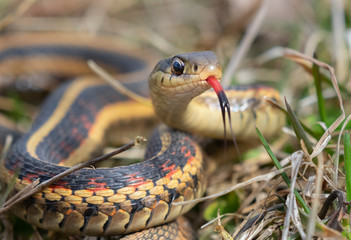
Distribution
The common garter snake is like the everyman of North American snakes. You can find this snake in nearly every U.S. state, all across Canada, and even in parts of Mexico. It boasts the broadest range of any snake in North America.
Thanks to its adaptability, there are over a dozen recognized subspecies, such as:
– Eastern Garter Snake (T. s. sirtalis)
– California Red-Sided Garter Snake (T. s. infernalis)
– Chicago Garter Snake (T. s. semifasciatus)
Each subspecies is tailored to its specific region, displaying slight variations in size, color, and pattern. Yet, they all unmistakably belong to the garter snake family.
Habitat
The garter snake’s versatility is truly its superpower. It loves hanging out in moist spots like wetlands, marshes, and along stream banks. But don’t be fooled—it also does great in dry meadows, deciduous forests, suburban parks, and even backyards. Water isn’t just a nice-to-have for them; it’s essential. Their favorite snacks, amphibians, are usually found near water, and that’s where the garter snakes like to be too.
You can often catch them soaking up the sun on rocks or logs. They might also burrow into garden mulch or sneak under a pile of leaves. When the cold months roll in, they seek out cozy spots like crevices, burrows, and even basements to hibernate safely.
Garter snakes have a knack for thriving in areas changed by humans. They’ve adapted well and coexist with us. Plus, these snakes are pretty important for keeping pests in check.
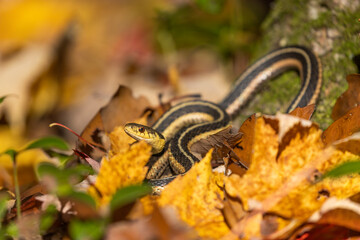
Diet
The diet of the common garter snake is as diverse as the environments it inhabits. These opportunistic feeders enjoy a smorgasbord of small creatures, including:
– Earthworms
– Frogs and toads
– Tadpoles
– Fish
– Slugs and snails
– Insects and larvae
– Small rodents
They use a mix of ambush tactics and active hunting to catch their meals. With sharp eyesight and a keen Jacobson’s organ, they’re pretty good at tracking down their prey.
Interestingly, some garter snakes have a mild neurotoxic venom that they deliver through their rear teeth. Don’t worry, it’s not dangerous to humans! This little adaptation helps them snag slippery prey like amphibians and fish. What’s more, garter snakes have a unique ability to tolerate toxins from certain toads, allowing them to feast on a food source that many other predators steer clear of.

Behavior
Garter snakes are most active during the day, especially when the weather is warm. While they might seem bold when they’re in our vicinity, they’re actually quite shy and tend to retreat quickly if they feel threatened.
Here are their main defense strategies:
– Speed and agility
– Camouflage
– Releasing a smelly musk from their anal glands
– Flattening their heads and hissing to look more intimidating
When the colder months roll in, garter snakes hibernate (or, more accurately, brumate) in special dens called hibernacula. These dens can be home to many snakes, sometimes dozens or even hundreds of them, all snuggling together to keep warm below the frost line.
Lifespan
In the wild, common garter snakes typically live around 4 to 6 years. But if they have a good food supply and few predators around, some can actually live much longer. In captivity, with the right care, these snakes have been known to reach ages of up to 15 years!
Young garter snakes face a tough start, as they have high mortality rates. They often fall prey to birds, mammals, and larger reptiles. However, those that make it past the juvenile stage can enjoy long, fulfilling lives. Many of them even return to the same den or basking spot year after year.
Reproduction and Lifecycle
The reproduction process in T. sirtalis is like a beautifully choreographed dance, all thanks to the changing seasons. As early spring rolls in, the males emerge from their winter slumber, eager to find females by following their pheromone trails. This leads to the exciting formation of mating balls, where groups of males compete for the attention of a single female.
Interestingly, the female has the ability to store sperm and can hold off on fertilization, allowing embryos to develop during the warmer months. Garter snakes are ovoviviparous, which means they give birth to live young instead of laying eggs. The gestation period typically lasts about 2 to 3 months.
When the time comes, she gives birth to anywhere from 10 to 40 little ones, each ready to fend for themselves right from the start. They emerge from a protective sac and quickly wriggle away, starting their independent lives without any need for parental care.
Predators
Garter snakes are pretty good at blending in and moving quickly. However, they have to watch out for a lot of predators, especially when they’re just hatched. Some of their common foes include:
– Hawks and owls
– Crows and herons
– Raccoons
– Skunks
– Foxes and coyotes
– Domestic cats and dogs
– Bullfrogs and larger fish (when they’re young)
When danger approaches, their first line of defense is their musk spray. If they feel threatened, they might thrash around, release a foul odor, and make a dash for water or dense vegetation. While their small size makes them easy prey, their agility and smarts give them a fighting chance.

Nest
The common garter snake doesn’t really make nests like you might expect. Instead, the females give birth to live young in safe, tucked-away spots. You can find these cozy places under logs, in compost heaps, or nestled among dense vegetation.
When it comes to hibernation, though, they gather in communal dens, known as hibernacula, which act as seasonal hideouts. These dens are often reused year after year and can be home to hundreds of snakes at a time.
These hibernation spots are crucial for surviving the winter, especially in colder areas. Without a deep, frost-resistant burrow, garter snakes face the risk of freezing during the chilly months.
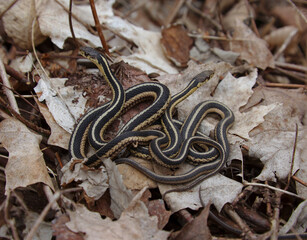
Adaptations
Thamnophis sirtalis has many adaptations that help it survive well:
- Striped Patterning: It helps animals blend in. This confuses predators and makes it hard for them to track their movements.
- Some groups can eat poisonous newts and toads. They are immune to the toxins in these animals.
- Mild Venom: Helps immobilize slippery prey like amphibians and fish.
- Temperature Regulation: Skilled baskers with behavioral adaptations to regulate internal temperature.
- Chemosensory Navigation: Their forked tongue and Jacobson’s organ let them “taste” the air for food or partners.
- Communal Hibernation: Sharing heat during brumation conserves energy in freezing temperatures.
Mating Season
As spring rolls in, the common garter snake kicks off its mating season right after shaking off the winter chill of hibernation. The males are the first to wake up, hanging around the entrances of their dens, eagerly anticipating the arrival of females. When a female finally makes her appearance, her pheromones send the males into a wild frenzy.
A swarm of males quickly gathers around a single female, creating a chaotic yet fascinating spectacle known as a mating ball. It might look messy, but it’s actually a clever strategy to increase the odds of successful fertilization.
Once the mating is done, the females head off to warmer spots to start their gestation period. Meanwhile, the males might go off in search of other partners before settling back into their usual routines.

Breeding
Females breed once a year and store sperm for delayed fertilization. By mid to late summer, they give birth to live young. Usually, this is between 10 and 40 babies, but larger females might have even more.
These young garter snakes are born encased in a thin sac they break free from immediately. At about 6–9 inches long, they are miniature versions of their parents. Within minutes, they’re off exploring, hiding, and hunting.
There’s no parental involvement beyond giving birth. Each baby snake must fend for itself in a world full of danger—and opportunity.
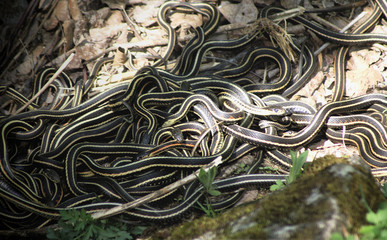
Interesting Facts
- Did you know these fascinating facts about garter snakes?
- Cold Tolerance Champions: Garter snakes are pretty impressive when it comes to cold weather. They can stay active while most other North American snakes are hibernating.
- Super-Sniffers: These snakes have a unique way of finding their prey and potential mates. By flicking their tongues, they tap into a remarkable chemosensory system that helps them navigate their world.
- Colorful Variants: In Florida, you’ll find blue-striped garters, while red-sided garters call California home. Their vibrant colors reflect the diverse habitats they thrive in.
- Toad Toxin Immunity: Some garter snake populations have built up a resistance to the toxins produced by amphibians, which can be lethal to many other predators.
- Snake Piles: When it’s time to hibernate, garter snakes can gather in huge numbers. Imagine stumbling upon a cave and seeing the floor completely covered with these slithery creatures!
- Eco-Friendly Pest Control: Garter snakes are fantastic at keeping insect and rodent populations in check. They’re like little guardians of the garden.
- State Symbol: The common garter snake proudly holds the title of the official reptile of Massachusetts.
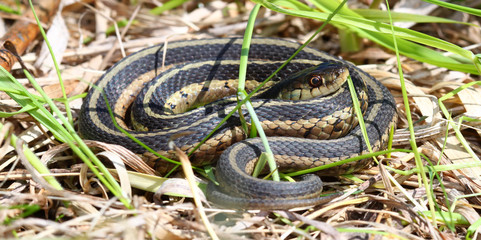
Conservation Status
- The common garter snake is classified as Least Concern by the IUCN, thanks to its ability to adapt, its broad distribution, and its diverse diet. But it’s not all smooth sailing for these snakes.
- Some subspecies, such as the San Francisco garter snake (T. s. tetrataenia), are facing serious challenges and are considered endangered due to habitat loss, pollution, and illegal collection.
- Here are some of the main threats they face:
- – Loss of habitat from agriculture and urban development
- – Mortality on roads
- – Pollution in wetland areas
- – Climate change impacts
- – Use of pesticides
- On the bright side, there are conservation efforts underway, including:
- – Preserving wetland habitats
- – Creating road-crossing tunnels
- – Running public education campaigns
- – Providing legal protection for at-risk subspecies
Final Thoughts
The common garter snake might not be as large as a python or as enigmatic as a cobra, but it has its own unique charm. This little creature is adaptable, graceful, and plays a vital role in our ecosystem. Snakes often glide silently through the underbrush of our lives, and while many of us may not notice them, they are essential in maintaining the balance of nature.
The garter snake reminds us that beauty and complexity can often be found right at our feet. Whether it’s basking on a warm rock or zipping through a garden, this fascinating creature never fails to capture our attention.


